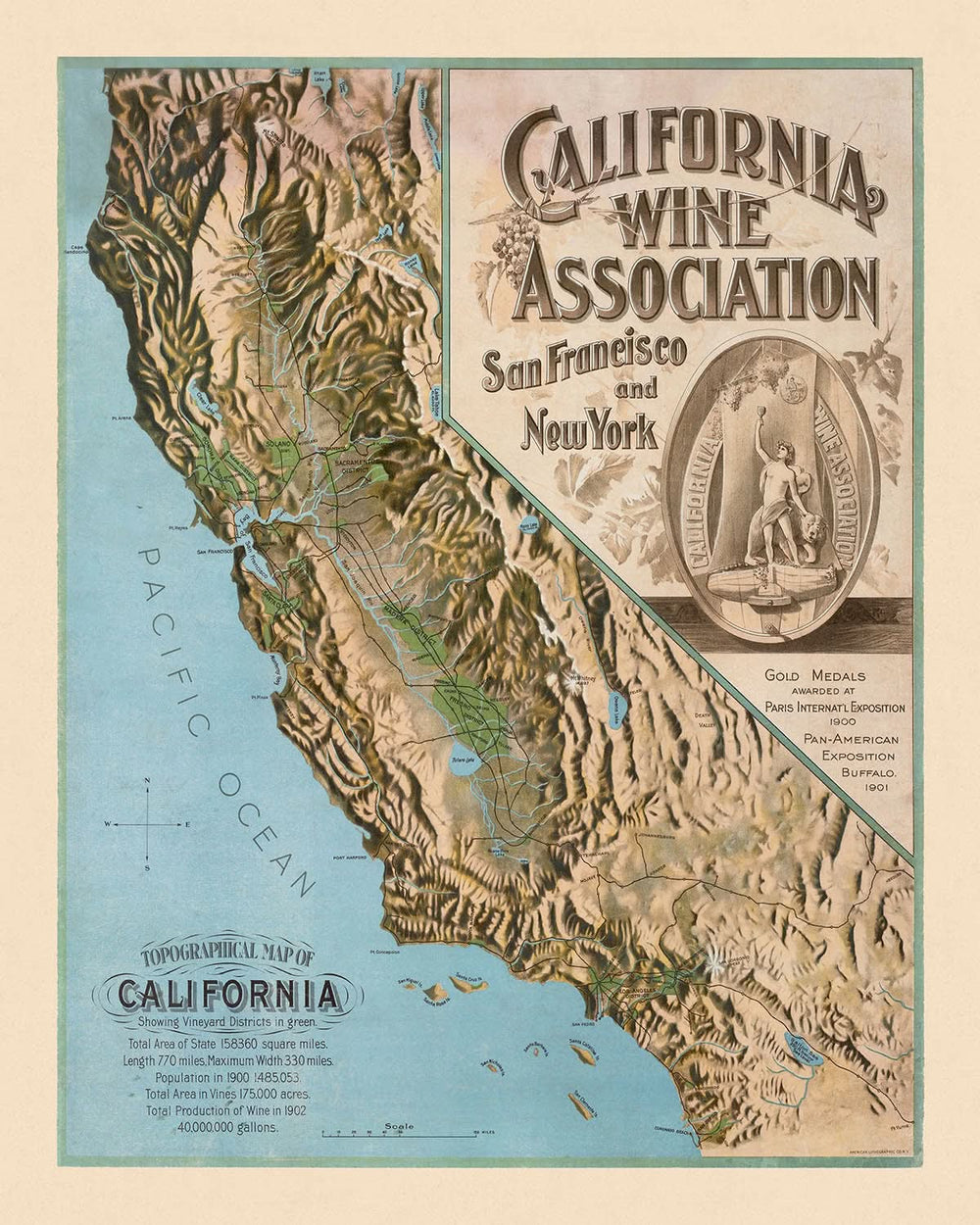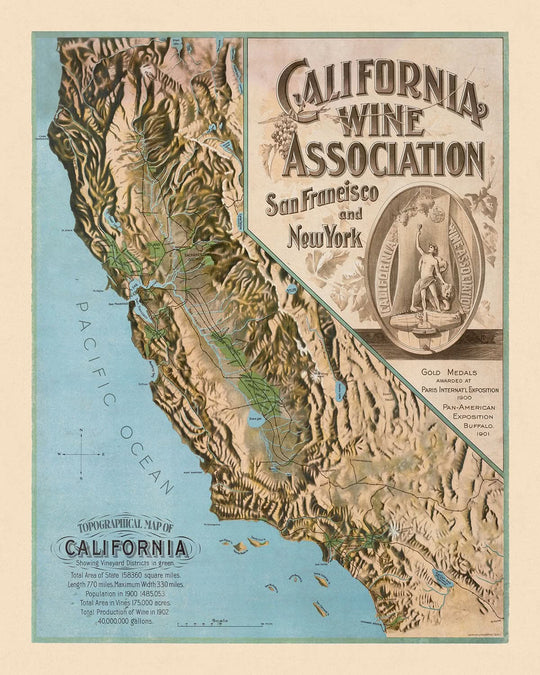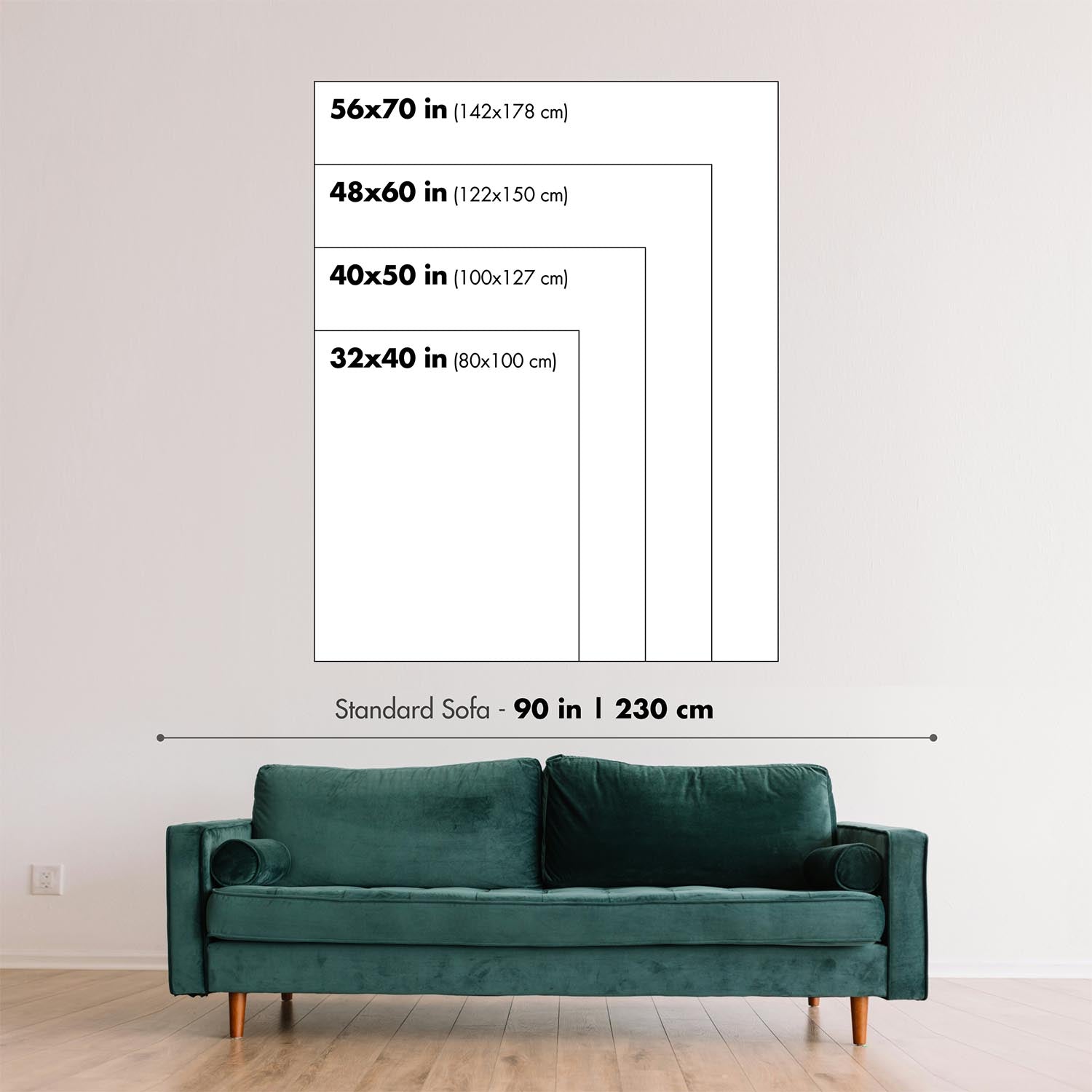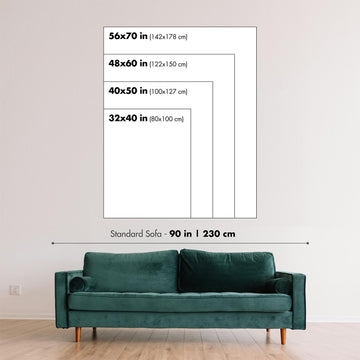- Handmade locally. No import duty or tax
- FREE Delivery by Christmas
- Love it or your money back (90 days)
- Questions? WhatsApp me any time
Own a piece of history
5,000+ 5 star reviews


Step into the rich tapestry of California's vinicultural history with the "Topographical Map of California Showing Vineyard Districts," crafted by the esteemed California Wine Association in 1903. This map serves as a fascinating snapshot of early 20th-century wine production, highlighting the flourishing vineyard districts that adorned the state. With its meticulous depiction of topographical features, the map captures the lush valleys that cradled these burgeoning wine regions, offering a glimpse into the landscape that shaped California's wine industry.
The California Wine Association, a powerhouse in the wine trade, played a pivotal role in the state's viticultural development. By controlling over 80% of wine production, the association not only influenced grape and wine prices but also established quality standards that stabilized the industry. This map, a promotional piece from the association, reflects their dominance and commitment to excellence, as evidenced by their accolades at the Paris International Exposition in 1900 and the Pan-American Exposition in 1901.
The map's design is a testament to the artistry and precision of early cartography. It features an intricate topographical relief that beautifully illustrates California's diverse terrain, from the verdant Napa and Sonoma districts to the lesser-known but equally intriguing regions like El Cajon Valley and the Los Angeles Basin. Each district is thoughtfully highlighted, inviting viewers to explore the rich tapestry of California's wine-growing areas, some of which have evolved into today's renowned wine-producing regions.
Beyond its vinicultural focus, the map also serves as a geographical exploration of California's natural beauty. The Pacific Ocean's vast expanse frames the state, while the San Joaquin Valley and other prominent features are depicted with remarkable detail. This blend of natural and cultural elements provides a comprehensive view of California's landscape, making it a valuable piece for both history enthusiasts and cartography aficionados.
Historically significant, this map not only chronicles the evolution of California's wine industry but also reflects the broader economic and cultural shifts of the era. As immigrants from Europe brought their viticultural expertise to the Golden State, they laid the foundation for what would become a global wine powerhouse. This map is more than just a representation of geography; it is a window into the past, capturing the spirit of innovation and resilience that defined California's early wine pioneers.
Cities and towns on this map
- Los Angeles
- San Francisco
- San Diego
- San Jose
- Fresno
- Sacramento
- Long Beach
- Oakland
- Bakersfield
- Anaheim
- Santa Ana
- Riverside
- Stockton
- Irvine
- Chula Vista
- Fremont
- San Bernardino
- Modesto
- Oxnard
- Fontana
- Moreno Valley
- Huntington Beach
- Glendale
- Santa Clarita
- Garden Grove
- Oceanside
- Santa Rosa
- Rancho Cucamonga
- Ontario
- Lancaster
- Elk Grove
- Corona
- Palmdale
- Salinas
- Pomona
- Hayward
- Escondido
- Sunnyvale
- Torrance
- Pasadena
- Orange
- Fullerton
- Thousand Oaks
- Visalia
- Simi Valley
- Concord
- Roseville
- Victorville
- Santa Clara
- Vallejo
- Berkeley
- El Monte
- Downey
- Carlsbad
- Costa Mesa
- Fairfield
- Temecula
- Inglewood
- Antioch
- Murrieta
- Richmond
- Ventura
- West Covina
- Norwalk
- Daly City
- Burbank
- Santa Maria
- El Cajon
Notable Features & Landmarks
- Napa District
- Sonoma District
- Solano District
- Sacramento District
- Madera District
- Fresno District
- Santa Clara District
- Livermore District
- El Cajon Valley
- Los Angeles Basin
- Inland Empire
- Bakersfield
- San Joaquin Valley
- Pacific Ocean
- Topographical relief depiction
- Emblem of the California Wine Association
- References to gold medals at Paris International Exposition (1900) and Pan-American Exposition (1901)
Historical and design context
- Name of the map: Topographical Map of California Showing Vineyard Districts
- Creation date: 1903
- Mapmaker/Publisher: California Wine Association
- Wine production: Highlights wine-growing regions in California in 1902, with a total production of 40,000,000 gallons.
- Design/Style context: Includes promotional elements and topographical features.
- Historical significance: Reflects the early 20th-century wine industry in California and the role of the California Wine Association in shaping wine production standards.
Please double check the images to make sure that a specific town or place is shown on this map. You can also get in touch and ask us to check the map for you.
This map looks great at every size, but I always recommend going for a larger size if you have space. That way you can easily make out all of the details.
This map looks amazing at sizes all the way up to 50in (125cm). If you are looking for a larger map, please get in touch.
The model in the listing images is holding the 16x20in (40x50cm) version of this map.
The fifth listing image shows an example of my map personalisation service.
If you’re looking for something slightly different, check out my collection of the best old maps to see if something else catches your eye.
Please contact me to check if a certain location, landmark or feature is shown on this map.
This would make a wonderful birthday, Christmas, Father's Day, work leaving, anniversary or housewarming gift for someone from the areas covered by this map.
This map is available as a giclée print on acid free archival matte paper, or you can buy it framed. The frame is a nice, simple black frame that suits most aesthetics. Please get in touch if you'd like a different frame colour or material. My frames are glazed with super-clear museum-grade acrylic (perspex/acrylite), which is significantly less reflective than glass, safer, and will always arrive in perfect condition.
This map is also available as a float framed canvas, sometimes known as a shadow gap framed canvas or canvas floater. The map is printed on artist's cotton canvas and then stretched over a handmade box frame. We then "float" the canvas inside a wooden frame, which is available in a range of colours (black, dark brown, oak, antique gold and white). This is a wonderful way to present a map without glazing in front. See some examples of float framed canvas maps and explore the differences between my different finishes.
For most orders, delivery time is about 3 working days. Personalised and customised products take longer, as I have to do the personalisation and send it to you for approval, which usually takes 1 or 2 days.
Please note that very large framed orders usually take longer to make and deliver.
If you need your order to arrive by a certain date, please contact me before you order so that we can find the best way of making sure you get your order in time.
I print and frame maps and artwork in 23 countries around the world. This means your order will be made locally, which cuts down on delivery time and ensures that it won't be damaged during delivery. You'll never pay customs or import duty, and we'll put less CO2 into the air.
All of my maps and art prints are well packaged and sent in a rugged tube if unframed, or surrounded by foam if framed.
I try to send out all orders within 1 or 2 days of receiving your order, though some products (like face masks, mugs and tote bags) can take longer to make.
If you select Express Delivery at checkout your order we will prioritise your order and send it out by 1-day courier (Fedex, DHL, UPS, Parcelforce).
Next Day delivery is also available in some countries (US, UK, Singapore, UAE) but please try to order early in the day so that we can get it sent out on time.
My standard frame is a gallery style black ash hardwood frame. It is simple and quite modern looking. My standard frame is around 20mm (0.8in) wide.
I use super-clear acrylic (perspex/acrylite) for the frame glass. It's lighter and safer than glass - and it looks better, as the reflectivity is lower.
Six standard frame colours are available for free (black, dark brown, dark grey, oak, white and antique gold). Custom framing and mounting/matting is available if you're looking for something else.
Most maps, art and illustrations are also available as a framed canvas. We use matte (not shiny) cotton canvas, stretch it over a sustainably sourced box wood frame, and then 'float' the piece within a wood frame. The end result is quite beautiful, and there's no glazing to get in the way.
All frames are provided "ready to hang", with either a string or brackets on the back. Very large frames will have heavy duty hanging plates and/or a mounting baton. If you have any questions, please get in touch.
See some examples of my framed maps and framed canvas maps.
Alternatively, I can also supply old maps and artwork on canvas, foam board, cotton rag and other materials.
If you want to frame your map or artwork yourself, please read my size guide first.
My maps are extremely high quality reproductions of original maps.
I source original, rare maps from libraries, auction houses and private collections around the world, restore them at my London workshop, and then use specialist giclée inks and printers to create beautiful maps that look even better than the original.
My maps are printed on acid-free archival matte (not glossy) paper that feels very high quality and almost like card. In technical terms the paper weight/thickness is 10mil/200gsm. It's perfect for framing.
I print with Epson ultrachrome giclée UV fade resistant pigment inks - some of the best inks you can find.
I can also make maps on canvas, cotton rag and other exotic materials.
Learn more about The Unique Maps Co.
Map personalisation
If you're looking for the perfect anniversary or housewarming gift, I can personalise your map to make it truly unique. For example, I can add a short message, or highlight an important location, or add your family's coat of arms.
The options are almost infinite. Please see my map personalisation page for some wonderful examples of what's possible.
To order a personalised map, select "personalise your map" before adding it to your basket.
Get in touch if you're looking for more complex customisations and personalisations.
Map ageing
I have been asked hundreds of times over the years by customers if they could buy a map that looks even older.
Well, now you can, by selecting Aged before you add a map to your basket.
All the product photos you see on this page show the map in its Original form. This is what the map looks like today.
If you select Aged, I will age your map by hand, using a special and unique process developed through years of studying old maps, talking to researchers to understand the chemistry of aging paper, and of course... lots of practice!
If you're unsure, stick to the Original colour of the map. If you want something a bit darker and older looking, go for Aged.
If you are not happy with your order for any reason, contact me and I'll get it fixed ASAP, free of charge. Please see my returns and refund policy for more information.
I am very confident you will like your restored map or art print. I have been doing this since 1984. I'm a 5-star Etsy seller. I have sold tens of thousands of maps and art prints and have over 5,000 real 5-star reviews. My work has been featured in interior design magazines, on the BBC, and on the walls of dozens of 5-star hotels.
I use a unique process to restore maps and artwork that is massively time consuming and labour intensive. Hunting down the original maps and illustrations can take months. I use state of the art and eye-wateringly expensive technology to scan and restore them. As a result, I guarantee my maps and art prints are a cut above the rest. I stand by my products and will always make sure you're 100% happy with what you receive.
Almost all of my maps and art prints look amazing at large sizes (200cm, 6.5ft+) and I can frame and deliver them to you as well, via special oversized courier. Contact me to discuss your specific needs.
Or try searching for something!
















































